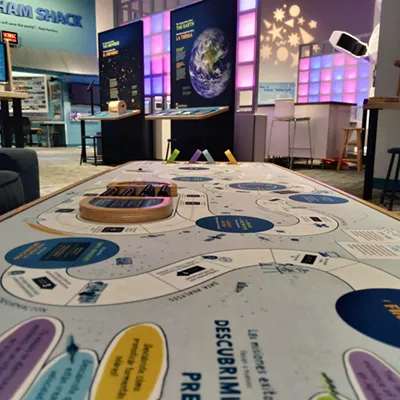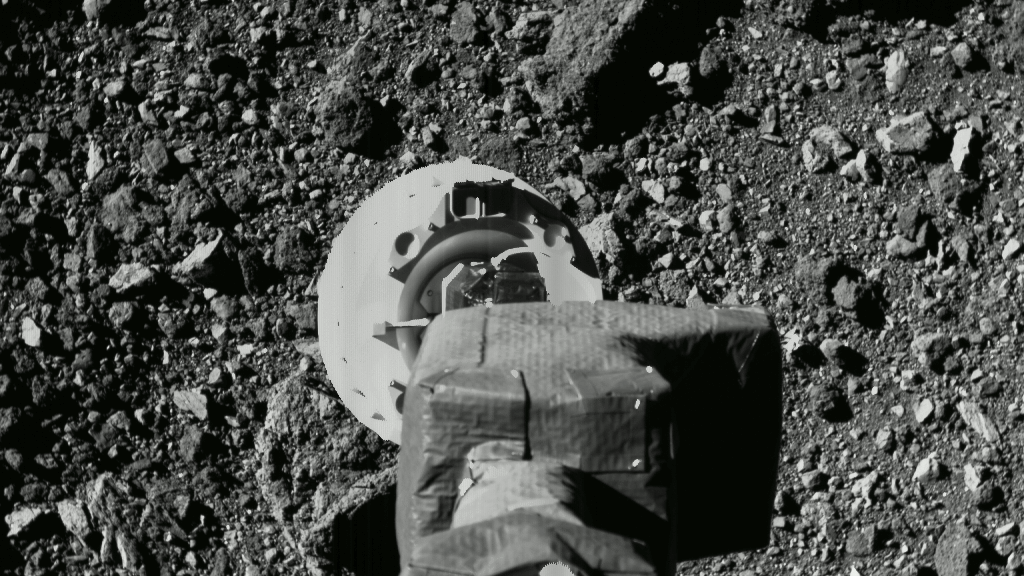The days were growing short for Phoenix, the NASA lander that had been transmitting data back to the UA Lunar and Planetary Laboratory since touching down near the Martian north pole on Memorial Day weekend. As the Martian winter set in, temperatures were dropping to minus 130 degrees Fahrenheit, and the skies were growing darker. The sun, which had never set during the prime months of the mission, was now sinking beneath the horizon for roughly seven hours a day.
Phoenix's solar arrays were capturing less sunlight to power the batteries that ran the heaters that kept electronic components warm in the frigid cold. For the first time, Phoenix began to shut down completely and then reboot itself after sunrise.
"We knew the end was coming," says Peter Smith, the UA professor who headed up the science end of the Phoenix mission. "We called our last few weeks the 'hospice mode.' We knew it was going to go, but it's kind of slow and painful."
In a last-ditch effort to stretch a few more days out of Phoenix, the team was about to start shutting down the heaters that protected the robotic arm, the onboard laboratories and other functions. They hoped there would be enough power to keep some of the other sensors working, so they could transmit temperature and pressure readings.
But before they could send the commands, the dust storm rolled in, blocking the sunlight that the solar arrays needed to charge Phoenix back up. The heaters burned through the batteries and knocked the onboard computer out of sync.
Phoenix hasn't been heard from since Sunday, Nov. 2.
"Just when we were vulnerable, we got whopped," Smith says. "Phoenix got into a funny state. It wasn't listening at the times when we were trying to communicate, and when it was listening, we didn't have a satellite (to relay the signals back to Earth) overhead."
As the temperatures around Phoenix continue to drop in the weeks ahead, the carbon dioxide in the atmosphere will freeze, encasing the lander in dry ice. By the time it thaws next year, the battered spacecraft will be in no shape to phone home.
But during its brief life in one of the harshest environments on Mars, Phoenix accomplished everything it was designed to do--and more. A robotic arm scooped loads of soil into onboard labs for analysis. Cameras snapped thousands of photos. A weather station collected daily readings. An oven verified that beneath the dirt is a vast field of frozen water. And in one of the last transmissions, scientists learned that the sensors detected snow falling from Martian clouds.
"While we're losing a spacecraft, it's really more of an Irish wake than a funeral," says Doug McCuistion, director of NASA's Mars Exploration Program. "We should celebrate what the Phoenix team has done and where it's going to take us in the future."
Even though he would have liked a few more days with his robot, Smith calls the mission "the thrill of my life."
"You can always think, wouldn't it be nice if you had this extra measurement, or that extra measurement?" Smith says. "But the fact is, we've gotten a really good data set, and now it's time to understand it."
There's plenty to pore over. For 23 weeks after landing, Phoenix used the most sophisticated instruments ever placed on a robotic space lab to deliver data by the terabyte to a command post set up in a former warehouse on the edge of downtown, at Sixth Avenue and Drachman Street. There, a team worked around the clock communicating with Phoenix for the first three months of the mission. Phoenix would transmit data above Mars to the Mars Reconnaissance Orbiter or Mars Odyssey. Those spacecraft would send the signals to the Jet Propulsion Laboratory, which would in turn bounce it to Tucson.
A download team would study the incoming reports--photos, lab analyses, weather readings--and decide how to use the robotic arm to scoop up a sample of soil, point a camera to develop a complete mosaic of the landing site or execute another manuever. Then an upload team would write and transmit the code to put Phoenix to work, whether it was snapping more photos or digging a trench.
"It's not quite like driving a car," Smith says. "It's like programming your car to go to the grocery store and buy groceries and then come back to you."
Now the science team is crunching the data, writing papers for scientific journals and preparing to present the results at conferences around the world. "We still have a lot of untangling to do," Smith says.
Among the questions that remain unanswered: Is there any sign of life on Mars? While it's too cold for Earth-like life to exist today, Smith says the jury is still out as to whether it was there sometime in the past.
"I'm still holding out hope here," Smith says. "We're trying to make sure we get the right answer and are not coming rushing out with a quick analysis. This is very tricky stuff, and the data sets are quite complex in regards to organics."
NASA will be funding the Phoenix mission through next summer. Smith has been putting off the question of what he'll do next. "It kind of depends on what we find," he says.
But he's confident that Mars exploration has just begun.
"If you look back through human history, you see that as possibilities open up to people, like sea travel, people didn't say, 'Let's not do it.' They started doing it right away," Smith says. "Magellan says, 'I'm going around the world.' Columbus says, 'I'm going to the West Indies.' These people risked their lives for these things.
"As space opens up, it's not for us to say, 'Hey, let's not explore space. Let's just stay at home and read the newspaper and sit by the fire and put our feet up.' Somebody has to do it."
Seven Minutes of Terror
The HiRISE camera aboard the Mars Reconnaissance Orbiter caught a snapshot of the Phoenix as it descended toward Mars on Sunday, May 25.After a nine-month voyage following its launch from Cape Canaveral, Fla., the Phoenix had to survive what was dubbed the "seven minutes of terror" to land on Mars. The spacecraft hit the atmosphere 78 miles above the surface of the planet at nearly 13,000 mph. It slowed to slightly more than twice the speed of sound, popped a parachute and ditched its heat shield. Then it dropped to within a kilometer of the surface, lost the chute, fired its thrusters and touched down on Mars.
"That was the sweaty-palms moment," says Peter Smith of the UA Lunar and Planetary Laboratory, who was the principal investigator on the mission.
Alfred McEwen, the LPL professor who oversees HiRISE, said the camera had only one chance to snap the picture of the lander's descent. McEwen was clearly thrilled by the photo, which was taken when the MRO was about 760 kilometers from the Phoenix. But he downplayed the astonishing achievement on the day it was released.
"It's just math," said McEwen.
In 2002, William Boynton, of the UA Lunar and Planetary Lab, first deduced the existence of vast sheets of permafrost beneath the surface of the northern plains of Mars while he was studying data from the Gamma Ray Spectrometer aboard the Mars Odyssey.
That discovery made the area a natural target for the Phoenix to land, because NASA wants to study any trace of water on Mars as a step toward determining whether life could have existed on the planet.
Phoenix spotted an ice patch just days into the mission, when the camera onboard the robotic arm got a peek underneath the lander.
"When we looked under the lander, we were standing on it," says Peter Smith, who headed up the Phoenix science mission. "The thrusters had just blown the soil all away."
The ice patch was dubbed "Holy Cow," based on the reaction it got when the Phoenix team first saw the image.
Getting an ice sample from a nearby trench to the onboard Thermal and Evolved Gas Analyzer proved to be one of the trickiest challenges for the Phoenix team, because the ice samples quickly "sublimated," or went from a frozen state to a gas--a problem compounded by the clumpy nature of Martian soil.
"We were having a heck of a time," recalls Smith.
Only one ice sample eventually made it into the TEGA, which analyzed the vapors as it was slowly baked to verify that it was frozen water.
Weird Soils of Mars
The robotic arm aboard Phoenix was put to work in the early days of the mission, delivering soil samples to the Thermal and Evolved Gas Analyzer (TEGA) and the Microscopy, Electrochemistry and Conductivity Analyzer (MECA) units aboard the laboratory.But the soil turned out to be so sticky that it wouldn't fall through the screens into the labs' cells. It took days of shaking the screens before the first sample finally landed in one of the cells on the TEGA, a collection of eight ovens designed to sniff the gases given off by samples that were slowly heated.
"We were frustrated by our lack of knowledge about Martian soil," Smith says. "We tried many different soils in our laboratories, but we never tried stuff like that."
The team considered some desperate measures at times. For example, they used a replica of Phoenix in Tucson to test some maneuvers that included using the scoop on the robotic arm to try to open the doors on the TEGA oven a little wider.
"We came to the conclusion that it was probably best not to try those on Mars," says Smith, although he did go so far as to use the scoop to try to push a sample through the screen on the MECA, a wet-chemistry lab that included an atomic-force microscope.
Tests of the soil revealed that it was loaded with perchlorate, a compound that has one chlorine atom surrounded by four oxygen atoms. Smith says perchlorate could provide an energy source for microbes that could feed off the oxygen, as they do on Earth.
The discovery is important for any manned mission to Mars, because perchlorate is a toxin that causes thyroid problems in humans. "If you're going to Mars and are going to be breathing in perchlorate," says Smith, "you have to worry about the toxic affects on astronauts."
If he had to design the instruments aboard the Phoenix again, Smith knows one thing he'd do differently: "I'd make the screens a little bigger."
In the Trenches
A trench dug by the robotic arm uncovered ice beneath the surface. These photos show how the ice sublimates, or evaporates into gas, on Mars. In the photo on the left, taken on June 15, there are tiny lumps of ice in the lower left-hand corner of the trench. In the photo on the right, taken four days later, the ice has vanished.











